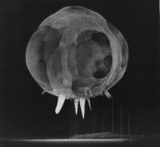
Operation Tumbler-Snapper
Encyclopedia
Operation Tumbler-Snapper was a series of atomic tests
conducted by the United States in early 1952 at the Nevada Test Site
. The Tumbler-Snapper Series of tests followed Operation Buster-Jangle
, and preceded Operation Ivy
.
The Tumbler phase consisted of three airdrops which were intended to help explain discrepancies in the actual and estimated blast shock wave
damage noted on previous detonations, and to establish more accurately the optimum height of burst.
The Snapper phase consisted of 1 airdrop and 4 tower shots intended to test various new weapons developments.
The military exercise Desert Rock IV, involving 7350 soldiers, took place during the test series. They trained during the Charlie, Dog, and George shots and observed shot Fox.
The individual shots were:
Nuclear testing
Nuclear weapons tests are experiments carried out to determine the effectiveness, yield and explosive capability of nuclear weapons. Throughout the twentieth century, most nations that have developed nuclear weapons have tested them...
conducted by the United States in early 1952 at the Nevada Test Site
Nevada Test Site
The Nevada National Security Site , previously the Nevada Test Site , is a United States Department of Energy reservation located in southeastern Nye County, Nevada, about northwest of the city of Las Vegas...
. The Tumbler-Snapper Series of tests followed Operation Buster-Jangle
Operation Buster-Jangle
Operation Buster-Jangle was a series of seven nuclear weapons tests conducted by the United States in late 1951 at the Nevada Test Site. Buster-Jangle was the first joint test program between the DOD and Los Alamos National Laboratories. 6,500 troops were involved in the Desert Rock I, II, and III...
, and preceded Operation Ivy
Operation Ivy
Operation Ivy was the eighth series of American nuclear tests, coming after Tumbler-Snapper and before Upshot-Knothole. Its purpose was to help upgrade the U.S. arsenal of nuclear weapons in response to the Soviet nuclear weapons program...
.
The Tumbler phase consisted of three airdrops which were intended to help explain discrepancies in the actual and estimated blast shock wave
Shock wave
A shock wave is a type of propagating disturbance. Like an ordinary wave, it carries energy and can propagate through a medium or in some cases in the absence of a material medium, through a field such as the electromagnetic field...
damage noted on previous detonations, and to establish more accurately the optimum height of burst.
The Snapper phase consisted of 1 airdrop and 4 tower shots intended to test various new weapons developments.
The military exercise Desert Rock IV, involving 7350 soldiers, took place during the test series. They trained during the Charlie, Dog, and George shots and observed shot Fox.
The individual shots were:
| Name | Date | Area | Yield | Device | Type | Purpose | Note |
|---|---|---|---|---|---|---|---|
| Able | 1 April 1952 | Area 5 | 1 kt | Airdrop | Weapons Effects | ||
| Baker | 15 April 1952 | Area 7 | 1 Kt | Airdrop | Weapons Effects | ||
| Charlie | 22 April 1952 | Area 7 | 31 Kt | Airdrop | Weapons Related | ||
| Dog | 1 May 1952 | Area 7 | 19 Kt | TX-7 | Airdrop | Weapons Related | |
| Easy | 7 May 1952 | Area 1 | 12 Kt | Tower | Weapons Related | First use of beryllium as a tamper material | |
| Fox | 25 May 1952 | Area 4 | 11 Kt | Mark 5 Mark 5 nuclear bomb The Mark 5 nuclear bomb and W5 nuclear warhead were a common core nuclear weapon design, designed in the early 1950s and which saw service from 1952 to 1963.... |
Tower | Weapons Related | |
| George | 1 June 1952 | Area 3 | 15 Kt | Mark 5 Mark 5 nuclear bomb The Mark 5 nuclear bomb and W5 nuclear warhead were a common core nuclear weapon design, designed in the early 1950s and which saw service from 1952 to 1963.... |
Tower | Weapons Related | |
| How | 5 June 1952 | Area 2 | 14 Kt | Tower | Weapons Related |

